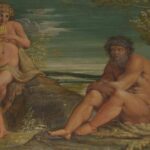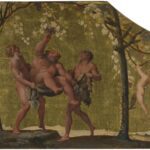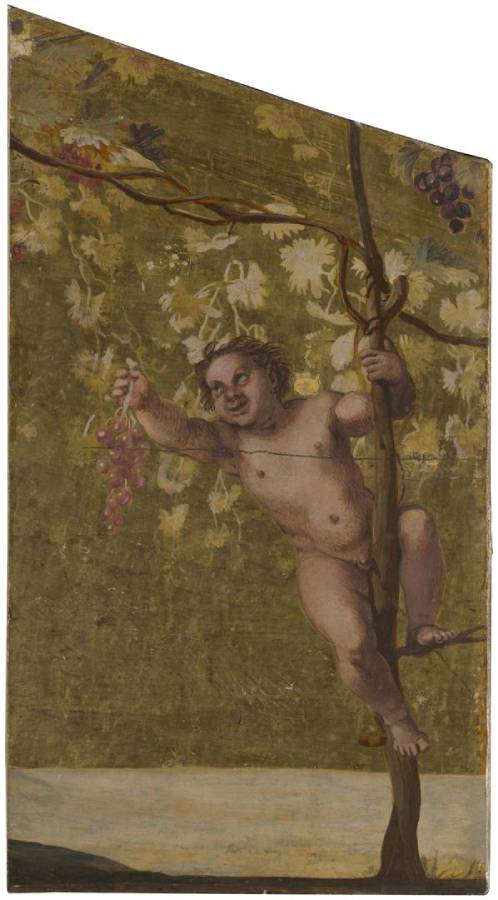Carracci, Annibale (1560-1609)
Giovane Satiro che raccoglie l’uva (Young Satyr gathering Grapes)
1597–1600
Oil and egg on wood, 54.5 x 88.5 cm
National Gallery, London
A naked young satyr, just like a little boy but with pointed ears and a curly tail, swings from a vine to pick grapes. This irregularly shaped panel was part of a musical instrument, probably a kind of harpsichord. Together with Silenus gathering Grapes it would have formed the inside of the lid, visible when the instrument was open, with this boy facing his ‘twin’ swinging on the vines in the larger panel.
A third panel, Marsyas and Olympus, may have been the keyboard lid from this or a paired instrument. All were painted by Annibale Carracci, possibly for Fulvio Orsini, the classical scholar and librarian of the Farnese family. The artist had moved to Rome by November 1595 at the request of Cardinal Farnese. He worked first on the Camerino of the Palazzo Farnese and then probably began the Gallery in about 1597, in collaboration with his brother Agostino (see Cephalus carried off by Aurora in her Chariot and A Woman borne off by a Sea God, drawings for elements of the ceiling also in our collection). Stylistically, these paintings fit with his work on the Farnese Gallery and were probably done at around the same time.
Annibale was a prolific draughtsman, and often worked out his compositions on paper first. Several preparatory studies associated with this project survive. A drawing of the two child satyrs now in Frankfurt (Graphische Sammlung im Städelschen Kunstinstitut) may have been used as a cartoon for the lid: the size of the figures in it matches those in the painting, and it is rubbed on the back with chalk as if to prepare it for transfer. On the instrument, the left-hand satyr (now in Silenus gathering Grapes) is much higher than his ‘twin’, and the drawing itself has clearly at some point been cut in two, presumably in order to allow the two figures to be put at different heights.
The boys climbing vines might have reminded contemporary viewers of the famous fourth-century mosaics of the church of Santa Costanza in Rome, where putti play among vine tendrils. (NG)
The other panels:
 Carracci, Annibale (1560-1609)
Carracci, Annibale (1560-1609)
Marsia e Olimpo
1597–1600
National Gallery, London
 Carracci, Annibale (1560-1609)
Carracci, Annibale (1560-1609)
Sileno che raccoglie l’uva
1597–1600
National Gallery, London
These three panels were originally part of an early keyboard instrument, or possibly a pair of instruments, and show scenes of music-making and drinking. Silenus gathering Grapes and Young Satyr gathering Grapes are probably from the inside of the lid, and would only have been seen when the instrument was open. Marsyas and Olympus may have also belonged to the lid of the keyboard or to some part of the instrument’s case.
They were painted by Annibale Carracci in the late 1590s, perhaps for Fulvio Orsini, classical scholar and librarian/curator to the powerful Farnese family in Rome. The designs for some of the figures are based on classical objects owned by the Farnese. (NG)
